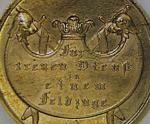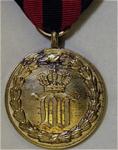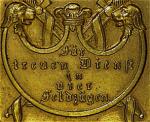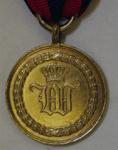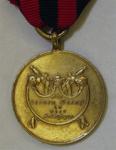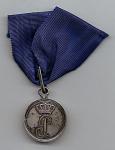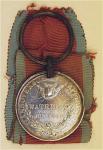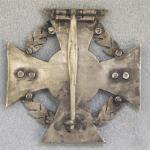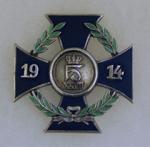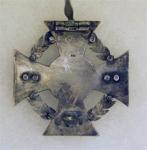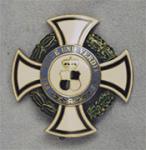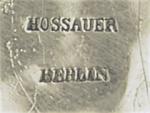-
Posts
2,856 -
Joined
-
Last visited
-
Days Won
9
Content Type
Profiles
Forums
Blogs
Gallery
Events
Store
Everything posted by Wild Card
-
Gentlemen, Around 1830-40 several German states instituted retroactive awards to the surviving veterans of the Napoleonic campaigns. States falling into this category include Anhalt-Bernburg, Baden, Hannnover and W?rttemberg. Below is an example of the W?rttemberg medal for the campaigns of 1793-1815 which was founded in 1840. The medal was awarded for the specific number of campaigns in which the recipient participated; ranging from one to twelve or fourteen (depending on the source). Obviously, rarity varies with the number of campaigns. There are two distinct obverse and reverse patterns; which is probably the result of replaced dies. The example below which is for four campaigns has the type 1 obverse and type 1 reverse. According to "Die W?rttembergischen Medaillen von 1797-1864" by Klein and Raff, this medal came as shown as well as with the type 1 obverse and type 2 reverse. From six campaigns up all medals had the type 2 obverse and type 2 reverse. The combinations for one, two and three campaigns get rather complex, especially when the reverses with and without the period at the end of the inscription are added to the mix; again, replaced dies (?). On with the show...
-
Gentlemen, Tom Y and Stogieman, both of your examples defy the ordinary in that these old cannon bronze medals most often develop black rust splotches. Tom?s medal shows the beginning of a small one; but not really detrimental. Won?t go into how rare ribbons of the period are; hang on to that one - at least the ribbon. Sorry about the deviation in the above post, I will get back to the campaign medals - Best wishes, Wild Card
-
Gentlemen, At the urging of a fellow member, I would like to present a thread dedicated to the Napoleonic era awards of the Imperial German states. We often feel a comfort level by concentrating on World War I and then, to varying degrees over time, work our way back through the Colonial and African campaigns to the Franco-Prussian War; but rarely go further than the war of 1866. The Napoleonic era awards reflect things that were to come. Some of the states and entities of that time (Anhalt-K?then, Hannover, Hessen-Kassel...) no longer existed, as such, by 1870; but their influence often lived on. From here, we work our way forward - it is hard to know where you are going, if you don?t know where you have been. Because of the extended time period and the relatively low number of awards, coupled with the fact that a comparatively low number of awards even existed at the time, these awards tend to be rare. Most of the orders which we admire so much were founded after this time; and, for the most part, the concept of civil merit medals, lifesaving medals and and long service decorations was yet to be embraced by all. So, I would like to invite all who have the interest and good fortune to have any of these decorations to share them with us. I will start with a Hannoverian Waterloo medal; Hannover being one of the states which ceased to exist by 1870 - having been on the losing side in the War of 1866; and subsequently being absorbed by Prussia. This medal, shown with a piece of original ribbon, was awarded to Soldat Johann Herwig of the Landw. Batt. Muenden. This reflects a nice feature of Hannoverian medals - the recipient?s name and title or military unit is impressed on the rim of the medal. This example has what is probably its original clasp and suspension ring, which is very rare. This clasp arrangement just did not hold up over time (especially in the case of recipients who spent time bouncing around on horses); hence the vast majority of these medals sooner or later wound up with replacement suspension devices, the variety of which really runs he gamut. Again, please join in and best wishes, Wild Card
-

Soviet Commissar Colonel Belykh's Researched Group
Wild Card replied to a topic in USSR: Soviet Orders, Medals & Decorations
Hi Rick, Thank you for a fantastic presentation on a super group. Best wishes, Wild Card -
Hi Stijn David, To add to the above information. I am inclined to believe that the neck decoration is from Schaumburg-Lippe, not Lippe. I base this on the fact that at some point (help out there?) Schaumburg-Lippe changed the background color of the center medallion of this order from white to red. Although the blue should be of a slightly darker shade, the blue and white ribbon with that of the EKII would be consistent with the blue ribbon with white stripes of the Schaumburg-Lippe Cross for Loyal Service which could be translated to their version of a war merit cross. I hope that this information is helpful. Best wishes, Wild Card
-
Gentlemen, David, I think that your theory makes a lot of sense. Since this award was founded in May of 1915, those 366 awards were stretched out over a considerable period of time. Typically, there were probably a considerable number of awards at the very beginning and then there was, as you put it, a ?relatively low demand...?. Stogieman, I do not think that all of the components were made in an initial run because if you check the several examples available, you will notice considerable variations. Unfortunately, I can not post it, but I took the picture of my piece and blew it up to match Marc?s and found the following differences. First, and most obvious, the body of Marc?s piece is slightly vaulted whereas mine is flat. The leaves on Marc?s piece are comparatively more rounded. The upper arm on the ?H?s? in the center medallions are different - Marc?s is straight across, top and bottom while mine is curved like a knife blade. The ?bows? at six o?clock show differences; and so on. Add in Nimmergut?s examples and you find more of the same. Dan, thank you for the compliment. Marc, message received, I agree, see you then. Wild Card
-
Hi Marc, Now you?ve got me going. As I said above, that 1914 Reuss cross has always been one of my favorites. One of the things that intrigues me about them is the many different ways in which they are constructed, especially when you consider that only 366 were awarded. I would point to the fact that Nimmergut illustrates yet two more variants. Following are pictures of my piece, which, unlike yours is flat. The manner in which the wreaths are attached is similar, if not identical; but you will notice that the ?19/14? devices on mine are also attached with pins or rivets. Also, mine is marked ?925? on the reverse. Question - does anyone have any information or theories regarding the many variations of this decoration? Thank you in advance. Best wishes, Wild Card
-
Hi fknorr, Yes! I got a couple of nice little medal bars, an award document a couple of the Mecklenburg campaign crosses and a real find - an 1871-91 Saxe-Altenburg silver merit medal! I have been looking for one of these for years; but have only been able to find the 1891-1908 model. So, a good show! Best wishes, Wild Card
-
Hi Claudio, It was for me a pleasure, as well, to meet you at the auction. It was unfortunate that we could not have spent more time together; I would really liked to have gotten your opinion on some of the items being offered. You are so right about being there to actually inspect the pieces. I went over with my list of bids; but after spending a good part of Friday looking at everything, my list saw considerable additions and subtractions. I also agree that, compared to the first two auctions, the prices in this one seemed somewhat ?firmed up?. I must confess that I would not have been surprised to have seen Meister?s spange go for even a bit more (I was expecting 20 - 23K); but you are far more knowledgeable about these than I. All in all, as I said above, rather than something for everyone it was a case of someone for everything - to the dismay of the dealers. Lastly, your point regarding security has to be considered by all of us. I find the situation a bit complex since if someone tried to steal something interesting from my home, what they would find is that it?s not kept here - so, what do we do then? Something to discuss next time we can get together - perhaps April in Kirchheim? Best wishes, Wild Card
-
It looks like I have been elected to give a report on the Thies auction which was held this past Saturday. So... this was the third Thies auction that I have attended - the last two (Dec. ?04 & April ?05) being the others. My expectation that the market has been saturated was heightened by the relatively slow turnout for the Friday preview, until the last couple of hours when the pace really picked up. Attendance on Saturday may have actually exceeded that of the previous two auctions. More than once there were three telephones going at the same item. If anyone wants to take the time to do some counting, I think that we may find a lower percentage of unsold lots in this auction. Rather than something for everybody, it was more like somebody for everything There were the to be expected ?gee whiz? items like the Black Eagle collar which went for 76,000 euro; but it should be noted that while it went for 52% over estimate, in my opinion, the real excitement was with the many ?lesser? pieces such as the Royal Hohenzollern member?s cross with swords which went for over three times estimate, the W?rttemberg Olga Order, again over three times the estimate and the Saxe-Altenburg fifty year decoration at over five times the estimate. All in all it was a very successful event; but to me, most importantly, it reflected a strength of diversity in particular interests within the field coupled with an appreciation of rarity over glitz and glitter. Best wishes, Wild Card
-
Gentlemen, Here is an early Hohenzollern Princely House Order, 1st cl. cross and it?s Hossauer mark (on the reverse). I might add that I also have a Hannoverian St. George star also marked to Hossauer which, unfortunately, lives too far from home to be retrieved in a timely manner - note, Hossauer was the original maker of the St. George stars, unusual for Hannover.


